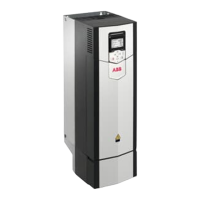Note:
• If the drive cannot produce the requested braking power during the routine,
the results will be based on the acceleration stages only, and not as accurate
as with full braking power.
• The motor will exceed the calculated maximum speed slightly at the end of
each acceleration stage.
Before activating the autotune routine
The prerequisites for performing the autotune routine are:
• The motor identification run (ID run) has been successfully completed
• Speed and torque limits (parameter group 30 Limits) have been set
• The speed feedback has been monitored for noise, vibrations and other
disturbances caused by the mechanics of the system, and
• speed feedback filtering (parameter group 90 Feedback selection)
• speed error filtering (parameter group 24 Speed reference conditioning)
and
• zero speed (parameters 21.6 and 21.7) have been set to eliminate these
disturbances.
• The drive has been started and is running in speed control mode.
After these conditions have been fulfilled, autotuning can be activated by parameter
25.33 (or the signal source selected by it).
Autotune modes
Autotuning can be performed in three different ways depending on the setting of
parameter 25.34. The selections Smooth, Normal and Tight define how the drive
torque reference should react to a speed reference step after tuning. The selection
Smooth will produce a slow but robust response; Tight will produce a fast response
but possibly too high gain values for some applications. The figure below shows
speed responses at a speed reference step (typically 1…20%).
80 Program features

